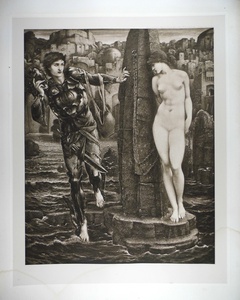| Method | Photogravure |
| Artist | after Sir Edward Coley Burne-Jones |
| Published | Published by the Berlin Photographic Company Berlin. _ London W.133 New Bond Street. _ New York 14 East 23rd Street. [c.1900] |
| Dimensions | Image 464 x 388 mm, Plate 534 x 448 mm, Sheet 667 x 507 mm |
| Notes |
Printed on India laid paper. Plate 71, taken from Burne-Jones' 1888/98-9 oil painting of the same title, from 'The Work of Edward Burne-Jones, Ninety-One Photogravures Directly Reproduced from the Original Paintings'. Only two-hundred copies of the 'The Work of Edward Burne-Jones...' were produced, each of which was signed by Philip Burne-Jones, the eldest son of Edward. 'The Rock of Doom' is the third of five oil paintings featured in Burne-Jones' unfinished series, 'The Perseus Cycle', which portrays the classical story of Perseus and the slaying of Medusa. Perseus, the son of Jupiter and Danaë, promises Polydectes, the King of Seriphos, that he would slay Medusa, the only mortal Gorgon, and bring her head to him. Having slain Medusa, Perseus, on his return home, passes through Syria. By chance, Perseus' arrival coincides with a sea-monster ravaging the land, as sent by Neptune. As declared by the oracle of Jupiter, the only way to appease the monster's wrath would be the sacrifice of Andromeda, the daughter of King Cepheus. Continuing with his journey home, Perseus encounters Andromeda, naked and chained to a rock. Struck by her exceptional beauty, Perseus offers to save Andromeda, should she agree to marry him. Burne-Jones portrays the moment that Perseus encounters Andromeda, removing his helmet so as to be visible to her. Although fearful of her fate, the appearance of Perseus offers hope to Andromeda's situation, which Burne-Jones captures through the static treatment of Andromeda's figure. Her fixed form juxtaposes against Perseus' swift movement, whilst her curved pose alludes to the S-shaped Madonnas and women prevalent in Gothic art. Andromeda embodies both the notion of the weak, vulnerable woman, and the highly sensual female figure common in the work of Burne-Jones, and more widely speaking, the work of the artists associated with Pre-Raphaelitism. Although 'The Perseus Cycle' recounts the myth of Perseus and Medusa, it is likely that Burne-Jones was looking to William Morris' 'Earthly Paradise' as the direct source for the series. Morris' epic poem, completed in 1870, retells myths and legends from Greece and Scandinavia. 'The Perseus Cycle' was based on an earlier set of ten gouache cartoons. In 1875, Arthur Balfour, a British statesman and arts patron, commissioned the series, with the hope of having ten oil paintings for his London home. Although working on the project for ten years, Burne-Jones' ill health meant that the works remained unrealised. Four of the oil paintings were finished, and one partially completed. The painting from which this photogravure was taken is now in the collection of the Staatsgalerie Stuttgart. Sir Edward Coley Burne-Jones, 1st Bt (1833-1898) was a painter and designer closely associated with the later phase of the Pre-Raphaelite movement. Burne-Jones met William Morris as an undergraduate of Exeter college, Oxford, whilst studying for a degree in theology. The pair went on to work very closely together on numerous decorative arts projects including stained glass windows, tapestries and illustrations. Originally intending to become a church minister, Burne-Jones never finished his degree, choosing instead to pursue an artistic career under the influence of Dante Gabriel Rossetti. Rossetti heavily inspired his early work, but by the 1860's his idiosyncratic style was beginning to develop. His mature work, however different in total effect, is rich in conscious echoes of Botticelli, Mantegna and other Italian masters of the Quattrocento. Thusly, Burne Jones' later paintings of classical and medieval subjects are some of the most iconic of the Pre-Raphaelite movement. He was at the height of his popularity during the 1880's, though his reputation began to decline with the onset of the Impressionists. He was created a baronet in 1894, when he formally hyphenated his name. The Berlin Photographic Company, (1880 - 1920; fl) or the Berlin Photographische Gesellschaft, was a German print publishers who specialised in photogravures after Old Masters and contemporary painters. High quality photographs were taken of the original works. The negatives were then exposed onto a gelatin covered copper plate, etched with acid, and printed in a similar fashion to an engraving. The main series of the Berlin Photographic Company's publications is kept together at Blythe House, West Kensington. Condition: Foxing and discolouration to margins, water stain to lower edge of sheet, slightly affecting image. |
| Framing | unmounted |
| Price | £600.00 |
| Stock ID | 41623 |

